Puppies have a lot of hyper energy and very short attention spans.
They are also infinitely curious and want to put everything that they see in their little mouths. This can make puppy obedience training something of a challenge.
When it comes to puppy training, we want to get our puppy to repeat good behaviors, and stop bad behaviors. The more a puppy practices a behavior, the more likely she will repeat it. Therefore, by encouraging good behaviors, we ensure that she will have a good repertoire of people friendly actions to draw upon when she grows up.
Here, we deal with the 3 primary elements of puppy obedience training –
- How to communicate consistently and effectively with a puppy.
- How to encourage good puppy behaviors.
- How to discourage bad puppy behaviors.

1. How to Communicate with Puppy

The first two words I teach my puppy are “Yes” and “No”.
“Yes” is used to mark a desirable behavior and “No” is used to mark an undesirable behavior.
Yes is usually followed by a positive consequence (e.g. a food reward, affection, toys), and No is usually followed by a negative consequence (e.g. withdrawal of attention, timeout).
In fact, we do not need to use the words “Yes” and “No”, and can pick whatever mark-words we want. The best mark-words are unique, and do not frequently come up in normal conversation. This helps to prevent confusion with our dogs.
For my dogs, I use Ack-Ack as a no-mark and Good-Boy or Good-Girl as a yes-mark.
- When my puppy does something good, I say “Good-Girl” and present her with a small treat reward.
- When my puppy does something bad, I say “Ack-Ack” and redirect her into doing something positive.
Consistency is very important while communicating with our dogs. We want to stick to the same yes-mark and no-mark.
In addition, we also want to establish very consistent rules and a fixed routine. This helps our puppy understand what is expected of her, as well as what she can expect from us.


One of the first things that I do with a new puppy, is set up a fixed routine. My puppy schedule includes playing time, training time, walking time, feeding time, and the ever important sleeping time. I try to keep the schedule consistent, so that each of these activities happen at around the same time every day.
Keeping a fixed schedule is good for me, and good for Puppy. It allows me to be more efficient about getting things done, and it sets aside some me-time while Puppy is sleeping and resting in her crate.
It also helps get a puppy accustomed to a new environment, without being overly stressed. In the beginning, everything is new, foreign, and possibly scary for a new dog. A fixed schedule helps to reduce stress, increase trust, and quickly integrates her into the existing family rhythm.
Similarly, a consistent set of rules will help to avoid confusion, and hasten the puppy learning process.
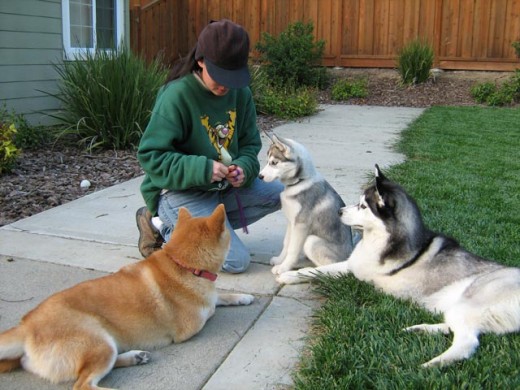
2. How to Encourage Good Behaviors
Puppy obedience training and even adult dog training is centered around two key areas-
- How to encourage and get puppy to repeat good behaviors.
- How to discourage and get puppy to stop bad behaviors.
It is important to recognize though that what we see as good and bad behaviors may not coincide with what our dog considers to be good and bad behaviors.
Dogs, even puppies, think for themselves and have needs of their own.
Therefore, we want to use our newly established communication system to teach our puppy what is good and bad for us. In addition, we must also motivate our dog so that she actually cares about our human values, which very likely, make little or no sense to her.


We encourage good behaviors by using the yes-mark, as soon as our dog finishes doing something good.
For example, when our puppy finishes doing a Sit we say “Good-Girl!” and then present her with a reward. The yes-mark is very helpful in training because it allows us to immediately mark the behavior that we want to reward.
To effectively train our puppy, we want to clearly indicate which action she is being rewarded for. If we wait too long, she will have moved on to something else, and we may inadvertently reward the wrong behavior.
Therefore, quickly use the yes-mark as soon as our dog finishes a good behavior. Then, we can take more time to present Puppy with her reward.

3. How to Stop Bad Behaviors
When it comes to stopping bad dog behaviors most of us think of applying a physical punishment, for example spanking the dog, jabbing the dog with our fingers, or giving the dog a collar correction.
These techniques apply pain to the dog, at which point the dog may stop her current behavior in order to avoid further pain and stress.
However, such pain based techniques are risky. If they are not executed with exactly the right force, timing, and redirection, they may cause more behavioral issues down the road; even aggression. It is especially risky to apply such techniques to puppies because of their young minds, and still developing bodies.
How then can we stop bad puppy behavior?

I have found that the best way to stop bad behavior is through the control of resources. *We* naturally control everything that a puppy wants, including food, toys, freedom, affection, and play.
To encourage good behaviors, we motivate our puppy by giving her something that she wants.
To discourage bad behaviors, we motivate our puppy by taking away something that she values, for example her freedom, or our attention and affection.
Note – This does not mean that we should tease our puppy and take away food while she is eating, or forcibly remove a toy that she is playing with. Doing so can encourage food aggression or resource guarding behavior.
What works best is to withhold something that my puppy wants, but does not yet have. Another possibility is to take away a privilege, such as withdrawing my attention or restricting her freedom.

When my puppy bites at my hands, I give her a no-mark (Ack-ack) and then redirect her to do something else, for example, chew on a toy. If Puppy redirects, I give her a yes-mark (Good-Girl), and reward her with something that she really wants, such as a yummy treat.
If Puppy ignores the no-mark and continues to bite at me, I withdraw my attention by standing up, folding up my arms, and turning away from her. In this way, she loses a valued play-mate, and no longer gets to engage in something fun.
If Puppy escalates her behavior and starts to jump on me or bite my clothes, I take away an even more important privilege; her freedom. I do this by calmly saying Timeout, and then taking my puppy to a boring but safe timeout area.
Puppies often bite at us to initiate play or to get our attention. We can effectively stop puppy biting by teaching her the following-
- Biting = No attention and no play,
- No biting = Attention, play, and treats.
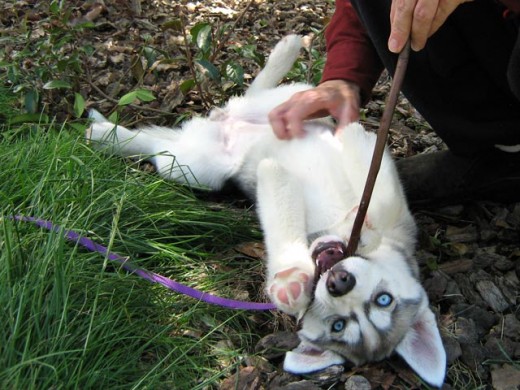
How to Train a Puppy
To stop bad behavior, I have found that it is important to –
- Start by redirecting Puppy into doing something positive. In this way, we turn a negative situation into a positive one. We not only get our dog to do what we want, but also teach her that following our commands, is the fastest way to get to her heart’s desires.
- Make the punishment suit the crime. I always start small and give my puppy many opportunities to choose a path for success. If she continues or escalates her bad behavior, then I slowly escalate her punishment.
- Stay calm at all times. Puppies have high energy and are easily distracted. If we get angry or frustrated, we will only inject more bad energy into an already volatile situation. This will likely cause our puppy to lose focus, become more hyper, and behave in an even more erratic fashion. If we want our dog to be calm, we must stay calm ourselves.
- Set Puppy up for success. Carefully manage our puppy and only expose her to situations that we think she can handle. For example, start by introducing her to new objects that are not moving, then slowly move on to moving objects, then objects that move and make noise, and so on. Start small and slowly move up to bigger things. The more successful a puppy is, the more confident she will become, and the more balanced she will be when she grows up.
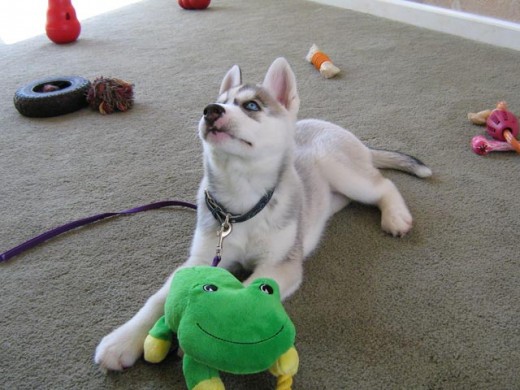
Goal of Puppy Obedience
The goal of puppy obedience is to learn how to communicate with our puppy, and teach her how to live well and harmoniously with us.
Obedience training can also help to protect our puppy from inadvertently harming herself and others, or from engaging in activities that may be detrimental to her health (e.g. over-eating, walking on glass).
Obedience training is *not* for acting out our anger, or venting our frustrations when our puppy poops on our furniture, eats poop, and spreads garbage all over our expensive designer couch.
We are not perfect, and Puppy is not perfect. In the initial stages, mistakes will be made, some of which may lead to chewed up designer shoes, scratched kitchen cabinets, and stained carpets. However, this is all part of the learning process.
Puppies, and indeed all dogs do not perform bad behaviors just to piss us off, make us angry, or exact revenge.
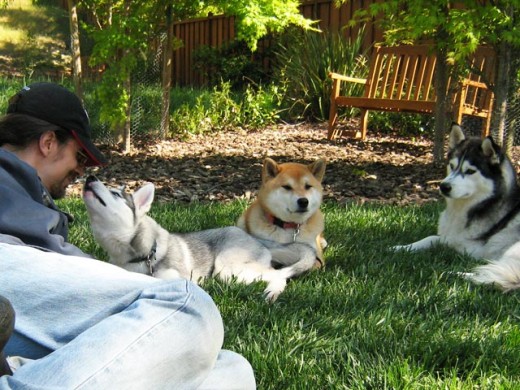
Puppies Acting Badly
Puppies or dogs act badly because …
- They do not know that something is bad because we did not teach them properly.
- They were stressed and started chewing, digging, or even pooping in order to relieve that stress (displacement behaviors).
- They felt threatened and thought it was necessary to protect themselves, or their belongings.
The key to puppy obedience training is in learning to see things from our dog’s point of view.
Once we understand what motivates our puppy, we can prevent undesirable actions and encourage desirable ones.
Dogs spend a lot of time observing us, understanding what makes us tick, and making us happy. The least that we can do, is try to return the favor.
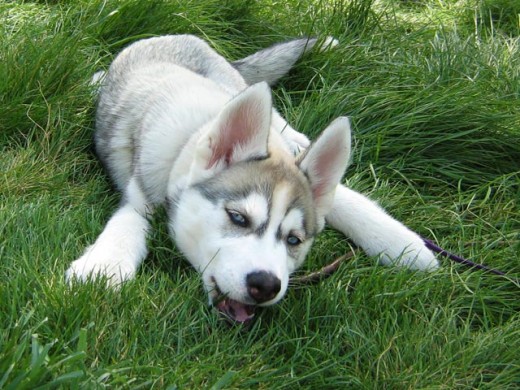
I recently adopted a 10 month old husky pup. I am the 3rd owner so he is lacking in training. The main problem is that he starts to bark in his crate at around 5 am every morning. He goes into the crate happily at night and I never use the crate as punshment. I’ve been trying to ignore this behavior but he doesn’t stop. Typically I let it go on for about 30 minutes then I get up and take him for a walk. Any suggestions to get him to sleep late?!
Thanks in advance.
David
One thing that helps with my dogs is to set up a very fixed routine, and to schedule a pee-break right before bed. In this way, they do not need to go as early in the morning. Still, I wake up at around 6 or 7 to let them out. Dogs are crepuscular, so they are most active during dawn and dusk.
Does your Husky go right away when you let him out in the morning? Is he vocalizing because he needs to go or because he is ready to start the day?
Hello, I’m getting a 8 week old Siberian Husky in one week. Her name is Luka. It’ll be my first husky, but I’m worried about introducing her to our 3 and a half year old White German Shepherd and Lab mix. His name is Bones. He’s male, and we’ve introduced him to other female dogs before, and usually he takes it well. But I’ve noted that he takes the dominance stance. He’s not that aggressive, and hardly barks at all. But he has snapped at other dogs if they get too close and they bark or bite at his face. Should I be worried for Luka? And do you have any helpful tips to introducing them?
Congratulations on your upcoming Husky puppy!
An 8 week old puppy is going to be really small, so a lot of supervision and management will be necessary. When I got my youngest Husky, I was not careful enough at first, and she got hurt during play with my adult dogs.
Here is more on what happened.
More on what I did when getting a second dog.
How I help my dogs get along.
Hi, I’m getting a Miniature Goldendoodle puppy in 2 weeks. It’s my first dog… do you have any tips for me?
Congratulations Maria!
This article on my first 10 days with a new puppy may be an interesting read. 😀
http://shibashake.com/dog/a-new-puppy-first-10-days-of-hell
I talk more about my other new puppy experiences here-
http://shibashake.com/new-dog-new-puppy
Make sure to take lots of pictures and have fun! Puppies can be a lot of work, but they are also extremely adorable and can be a whole lot of fun. I also love that puppy smell. Give your puppy a big hug from me when you get him/her. 😀
Hi, We have an 8 week old Siberian husky and we also have 3 cats. (I know not the best mix) but we talked to a trainer and a vet before getting her and they said as long as she’s raised with them she will be fine. My question is, How to stop her from playing with them to rough? She really loves to play with them but she likes to bite everything including them and myself. Thank you!
Congratulations on your new Husky puppy!
I don’t have any cats so I don’t have any firsthand experience in that area. I find the ASPCA to be a great resource for my dogs though, so here is their article on introducing a cat to a new dog –
http://www.aspca.org/pet-care/virtual-pet-behaviorist/cat-behavior/introducing-your-cat-new-dog
When I introduce a new dog to my *existing dogs* –
1. I put my new puppy on a leash so that I have good control over her and can teach her what the dog-to-dog interaction rules are. I can also stop her from pestering them when they do not want to be pestered.
2. I manage my puppy’s excitement level. When my Husky Lara was young, she would get over-excited and then play starts to get out of control. Therefore, I throw in many play-breaks so that play doesn’t get out of hand.
3. I try to create as many positive experiences as I can between the new puppy and my existing dogs, and at the same time I try to minimize bad interactions.
4. I set up a very fixed routine and consistent interaction rules. I supervise puppy very closely when she is out and about. When I cannot supervise, I put my puppy in her enclosure. In this way, she can’t start anything with my other dogs when I am not watching.
Big hugs to your puppy!
My husky pup (just turned a year old) surprisingly learned that he can be rough with a larger dog, and has to be gentle with my smaller dog & cat pretty much on his own.
Obviously observing and correcting when things go too far is important, but other than that I let him figure out how much others can handle, much in the same way that a gentle grab of my hand when he wants something is okay vs biting.
best advices!!!!
Hi, I happend to become a husky owner by faith.. A while ago ago a puppy somehow stumbled into my yard.. I have seen it a while ago walking around, but i thought the owner was somewhere around.. day after i realised it is lost and some kids were playing with him.. it came to my yard by its own will.. gave him food, water and I set up a temporary dog house for him. The owner hasnt looked for him.. So I decided to keep him. I dont really know how old it is but I think he is a few months old. The dog looked really healthy when I found him, wasnt skinny at all and his furr looked really well. I have some experience with dogs but never with a husky. I would appreciate any advice, on how should I check how old it is, traning, food etc. Tnx 🙂
What a clever puppy to find a good home for himself. 😀
In terms of age, I think a vet would be most equipped to estimate that based on his teeth and possibly other physical characteristics. When I get a new dog, I usually bring him to the vet for a check-up anyway, to make sure he is in good health and for his shots if necessary.
As for food, both of my Huskies have pretty sensitive stomachs so I try to limit the number of ingredients that I give them and stay away from most grains (with the exception of rice which they seem good with). I am currently giving my dogs Wellness CORE which is a grain free, high protein kibble. During puppyhood, I was using the Wellness puppy formula. More on how I picked my dog’s food.
For training and day to day care, my Huskies are pretty independent and high energy so I try to provide them with consistent rules and a fixed routine. I try to focus their energy into doing positive, structured activities with me, and I supervise them well, especially initially so that I can teach them what the house rules are and redirect undesirable behaviors. I also follow the Nothing in Life is Free program with all of my dogs. More on my training experiences with my dogs.
Congratulations on your new puppy!
i have a 1 month old Siberian husky cross breed with a Labrador she used to bite the electric wires inside the house, what should i do? i don’t have any experience in taking care of a dog it’s my first time of being a dog owner can you help me on how i can teach her a potty train? and i’m even scared in playing with her because i’m afraid that she might bite me
1 month is really young for a puppy to be separated from her mother and siblings. What was her situation before you got her? Usually puppies are kept with their mother until at least 8 weeks old. Here is why.
When my puppy is young, I make sure I am there to supervise her most of the time. In this way, if she bites on something she is not supposed to, I no-mark and redirect her onto something that she can bite on. If she redirects, I mark the behavior (Good), and then reward her by playing a fun game with her. In this way, she learns that some things are rewarding to bite on and some things are not.
If I am busy and unable to supervise (even for 1 minute), I put my puppy in a puppy-safe area such as her enclosure or crate. Below are some of my experiences with potty training and puppy biting. However, I got all my puppies at 8 weeks or more, so all of my experiences are with puppies of that age or older.
Here is how I potty trained my puppy.
More on puppy biting-
http://shibashake.com/dog/puppy-biting-tips-solutions
http://shibashake.com/dog/puppy-biting-how-to-stop-puppy-biting#timeout
The ASPCA also has some good articles on dog training. Places that I go to get information on dog behavior and dog training.
In the beginning, it was also helpful for me to consult with good professional trainers.
http://www.apdt.com/pet-owners/choosing-a-trainer/
HI, my name is Liz
So, my boyfriend and I are getting an 11 month old Siberian Husky this Saturday! I am so excited, I am making sure that before I bring this new pup home I have pee pads, a bed, food, etc. I have never had a husky before and am just wondering what to expect, how to start off training him, and also, is it too late to change his name??
Congratulations on your new furry family member!
In terms of training, I also follow the Nothing in Life is Free program, and I talk about my other training experiences with my dogs here.
As for my dogs’ names, they really are more for me than for them 🙂 I mostly use their names as markers for good and bad behavior. As such, teaching my dogs to “know” their names is really just a matter of consistency and training.
Give your Husky a big hug from me on Saturday! 😀
Do not use pee pads, all it does is give the dog the okay to soil in the house and add an extra step to learn
I have a 13 week old husky, how old would you recommend she should be before taking her for walks? The vet said Huskies get hip problems if you walk them too early?
I only took my Husky puppy out on neighborhood walks *after* she was fully vaccinated. As I understand it, puppies have developing immune systems and are a lot more susceptible to catching something bad such as parvo or distemper. Puppies are also very curious, so they are more likely to go smell poop from other dogs or other animals that may be contaminated, or drink contaminated water.
As for the hip issues you mention, is it concern over hip dysplasia or is it something else? It is perhaps best to follow-up with your vet on it, especially since he is the one who mentioned it. Here is an article from the ASPCA that has some good information on hip dysplasia.
She is now 18 weeks old – fully vaccinated, can I take her for walks? She has soooo much energy and while she does run around the back yard most of the day she is still very hyper.
Can I talk her for 30 min walks? IS this too much or not enough?
Hi, I love how much information you have about huskies. I can spend hours reading all the different posts. However, I do have some questions more specifically towards my 9 month old husky. First, a little background info… We got Koda when he was only 6 weeks old. (Bad situation with the breeder.) Potty training was a breeze; as well as simple commands like sit, down, shake, crawl, etc. When he got bigger, he started showing dominance to our 2 year old son. He (Koda) was aggressive and I consistently had him in timeout in the kennel. Once he became bigger than our son, he left him alone and started showing dominance to our 7 year old daughter. Still does. He will randomly nip at her for no reason. Koda has been pretty good with my husband and I. Not too aggressive. The last time he nipped my daughter I went to put Koda on his back, look him in the eye, and tell him no. He freaked out! He showed teeth, bit and kicked me; hard! I had a cut across my face from his nails. It scared me. He went to time out and started behaving better. (That was a week ago maybe.) Until today. I took him to a groomer to have the whole bath, brush, nail clipping treatment done; and they called me 10 minutes after I left. They couldn’t do anything to him because he was growling and showing teeth to them! I picked him up, took him home, and my husband and I gave him a bath at home. He was doing better and had calmed down. Just before bed my son went to hug Koda (he always does), and he growled and showed teeth to my son. My husband said no and spanked him. Koda went nuts again. He bit my husband 3 times, drew blood; it was like a completely different dog. I don’t know what’s happening. The past week has been a nightmare and he’s getting worse after we thought he was doing so well. Please help!! I care a lot about him but I fear for our safety now and question whether or not we should get rid of him. Sorry for the novel, I thought maybe a little background info would be helpful. Thanks.
-Kadee
If the dog is kenneled a lot and you are using kennels as negative re-enforcement, any time you put him in the kennel he will think you are upset with him. Stop using kennel as punishment. It should be the puppy’s/dog’s happy place.
From personal experience, I would guess inadequate exercise/attention. My dog was acting out at that age, it was at it’s worst in the 14-16 month and at a year and a half I stopped kenneling all together and all most all the issues disappeared.
My dog at that age probably would have had to been run 8-12 miles to really get her worn out, I wasn’t able to wear her out physically till she got arthritis at around 7. An old adage is a worn out dog is a well behaved dog is very true, but sometimes near impossible to get with a young husky.
It will get better if you can figure out the trigger, (my guess inadequate attention from head of pack, so acting out against pack member just above himself to try to improve pack postion and get more attention)
Huskies are definitely a challenging breed with their need for daily brushing and their constant need to push boundaries, but they are great jokesters. I hope you figure it out.
If you haven’t done a professional training class, do it. An average trainer is a million times better then a great book. Involve the kids, and it can be a lot of fun. Petsmarts and petcos do them. just over 100$ But definitely talk to a trainer before you do anything drastic.
I had a similar reaction with my Shiba Inu. Using the alpha roll and other physical based techniques ended up making him a lot more aggressive towards me, and I also lost a lot of his trust. Losing his trust made a lot of things very difficult, including grooming.
Here is more on my experiences with the alpha roll.
Here is more on why I no longer use physical based techniques with my dogs.
Here is a UPenn study which shows that physical based techniques have a high risk of actually increasing aggression in dogs.
After Sephy’s aggression increased because of my use of alpha rolls and other aversive based techniques, I became quite afraid of him. My fear only made his behavior get worse.
http://shibashake.com/dog/afraid-of-your-dog
I considered giving him back to the breeder, but the truth is, she was not a very good breeder and would not have accepted back an aggressive dog. No-kill shelters have a temperament test that they put dogs through before acceptance, which Sephy would not pass. I quickly realized that the chances of an aggressive dog getting adopted is almost none, which means that Sephy would essentially be put down. His temperament is such that being in a shelter environment would also cause him to suffer greatly.
I decided that I would do my very best to help change Sephy’s behavior. I started reading up a lot on dog behavior and I also contacted several professional trainers for help. We did individual sessions to troubleshoot particular issues. Group classes mostly focus on training commands, and were less helpful for us in terms of Sephy’s aggression.
I also did more research on Shiba breeders, and we went to visit several who gave us advice on the breed and their behavior. No one person helped to fix all of Sephy’s issues, but each person helped a little. The more I learned, the more I was able to understand what was truly causing Sephy’s behavior, and to come up with safe ways to manage him and help us both get to a better place. Here is a bit more on my experiences with Sephy-
http://shibashake.com/dog/pack-leader-to-an-aggressive-dog
http://shibashake.com/dog/zen-dog-training-tips
http://shibashake.com/dog/my-shiba-inu-story
For cases of aggression, it is usually best to get help from professional trainers. In addition, reading up on dog behavior helped me to better understand Sephy’s behavior, and find better trainers. I also totally stopped using risky physical based techniques.
http://www.apdt.com/pet-owners/choosing-a-trainer/